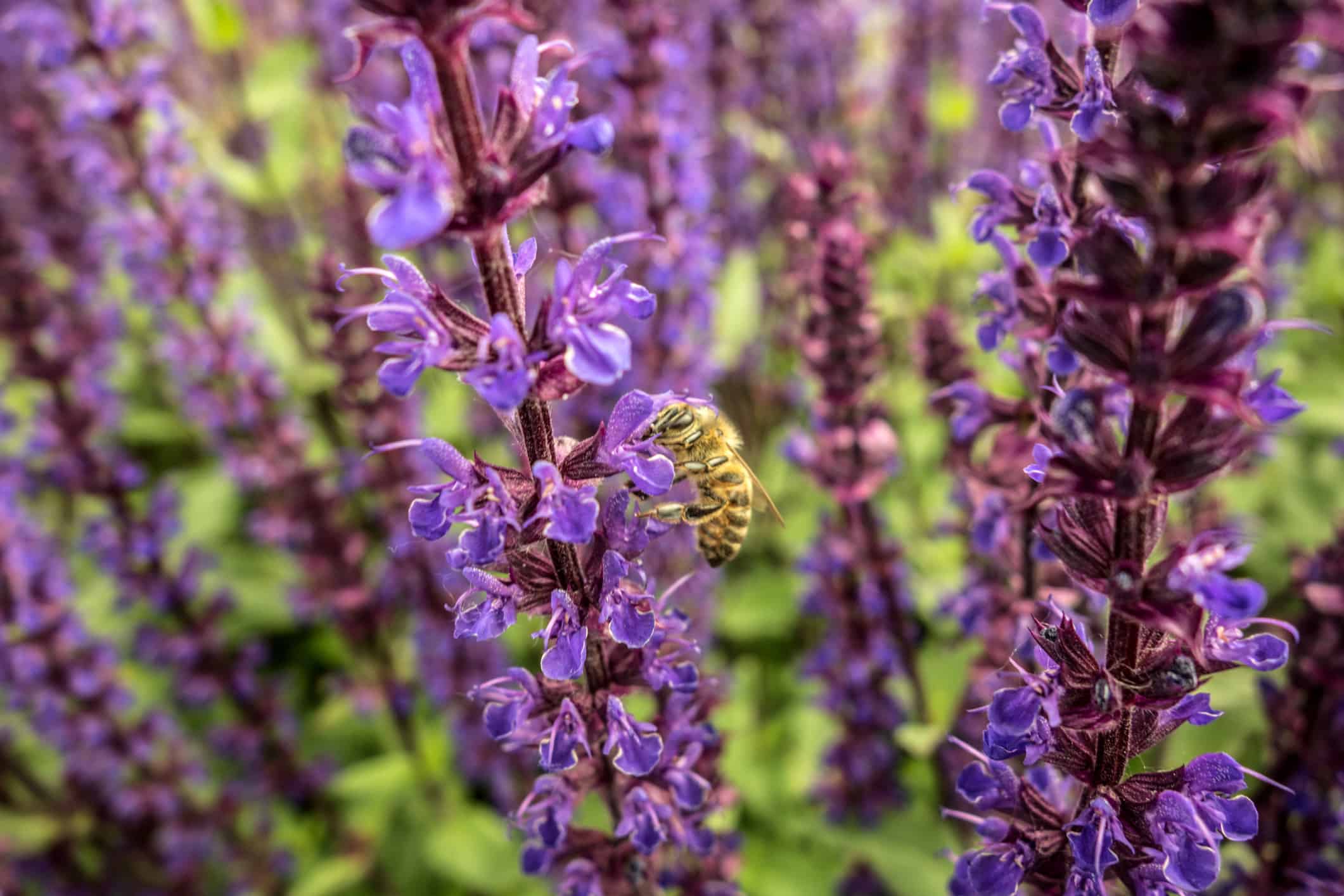Lavender, with its delicate purple blooms and soothing fragrance, has long been a favorite in gardens and homes around the world. However, numerous plants resemble lavender and even offer their unique charm and benefits. Discover sixteen plants that look like lavender, along with insights into how to care for each one.
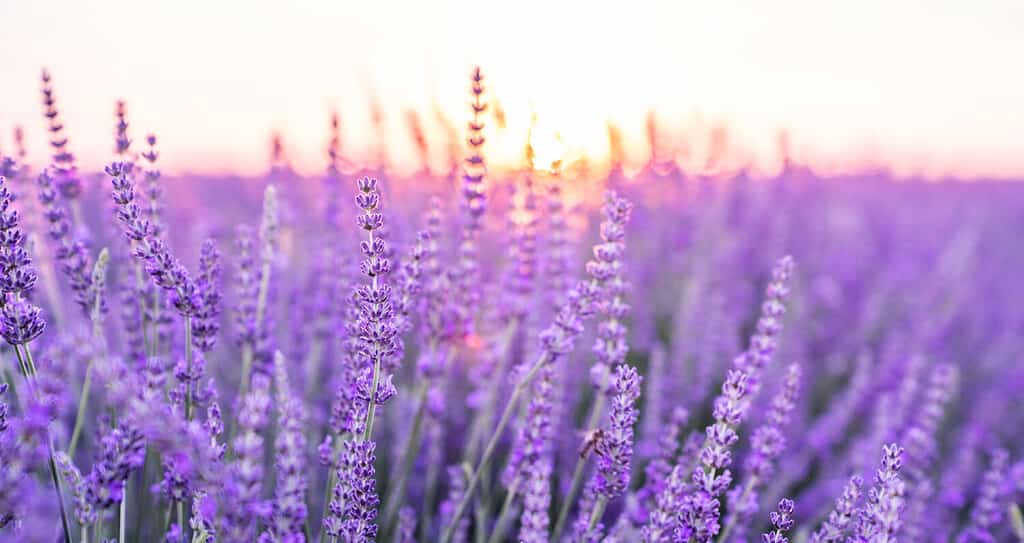
Lavender has delicate purple blooms and soothing fragrance.
©ESstock/Shutterstock.com
1. African Blue Basil (Ocimum kilimandscharicum × basilicum)
African blue basil is a delightful herb that bears a striking resemblance to lavender, both in its appearance and fragrance. It produces slender, elongated leaves, which are tinted with a deep green and often display a subtle purplish hue. This distinctive coloration creates an attractive contrast that closely mimics the visual appeal of lavender.
As the wind rustles through its foliage, it also releases a captivating, sweet fragrance that evokes the familiar scent of traditional basil, yet with delicate notes reminiscent of lavender. This unique blend of visual and aromatic similarities makes African blue basil a captivating lavender look-alike for your garden.
African blue basil is not only a visual delight but also a resilient and versatile herb in the garden. It thrives in full sun, so choose a well-lit spot in your garden or on your balcony. It also grows best in well-draining soil, so ensure good drainage to prevent waterlogged roots.
Keep the soil consistently moist but not waterlogged. Additionally, regular pruning encourages bushier growth and prevents legginess. Pinch off the tips of the branches regularly to promote branching, and feel free to harvest the aromatic leaves frequently, as doing so will encourage more growth and maintain the plant’s shape.
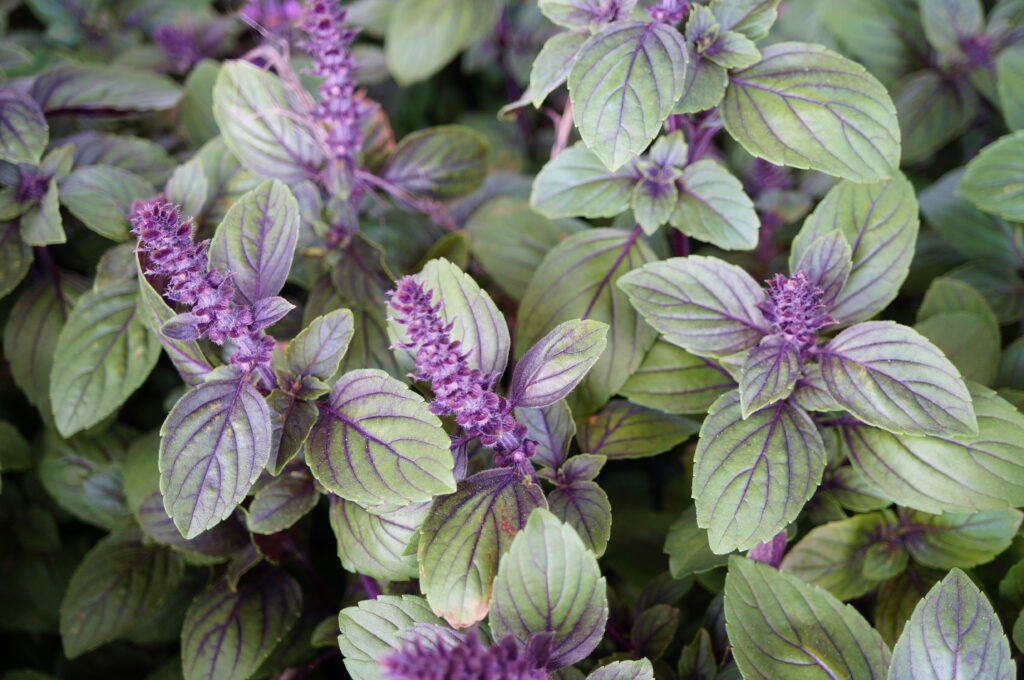
The African blue basil is a very rare variety that grows year-round.
©EQRoy/Shutterstock.com
2. Anise Hyssop (Agastache foeniculum)
Another captivating herb, anise hyssop, also shares several visual similarities with lavender while boasting its unique qualities. This herb features slender, lance-shaped leaves that are a vibrant green and occasionally tinged with hints of purple. Its tall, upright spikes of small, tubular flowers add a touch of elegance to your garden, resembling lavender blooms in their structure and arrangement.
Anise hyssop is not only visually appealing but also emits a delightful fragrance reminiscent of anise or licorice, which sets it apart from traditional lavender. It grows best in full sun but can tolerate partial shade. It also loves well-draining soil and prefers drier conditions.
Water moderately and regularly deadhead spent flowers to encourage continuous blooming and maintain a neat appearance. You can also harvest the leaves and flowers for culinary or herbal use, which also helps the plant to produce new growth. Anise hyssop is generally hardy but may benefit from a layer of mulch in colder climates to protect its roots from frost.
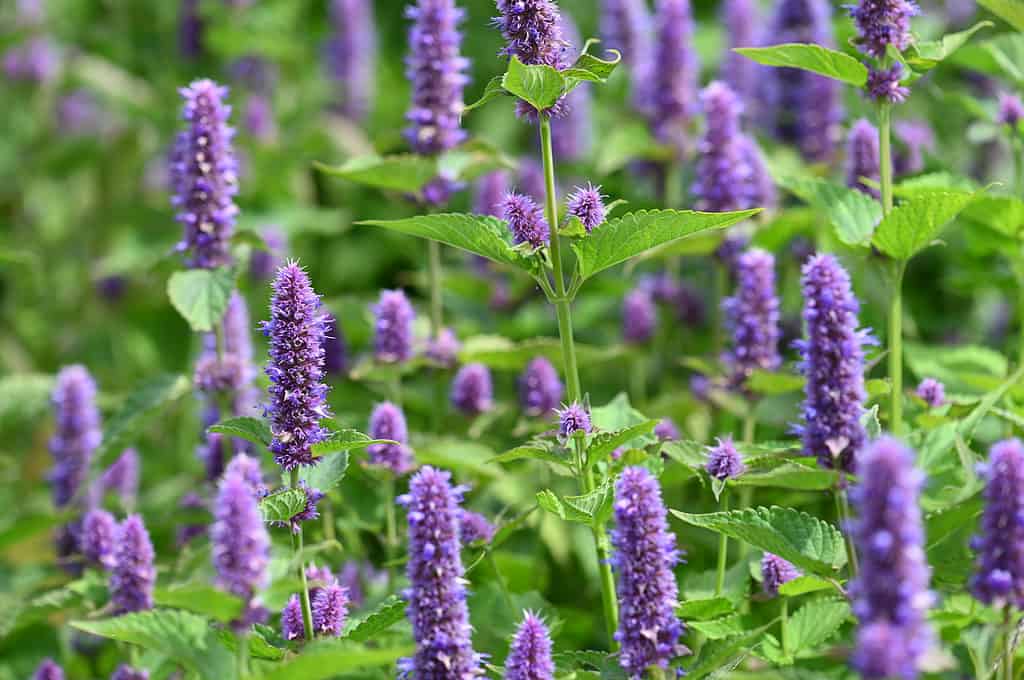
Indigenous peoples used anise hyssop to treat the common cold and digestive issues.
©iStock.com/BethAmber
3. Catmint (Nepeta spp.)
Catmint is an herbaceous plant known for its striking resemblance to lavender, particularly in terms of its foliage. Its leaves are gray-green, aromatic, and have a soft, silvery quality that closely mirrors the appearance of lavender leaves. The plant typically grows in a mounding form, producing tiny, tubular flowers in shades of blue, purple, or pink that also bear a resemblance to lavender blossoms.
While catmint may not mimic lavender’s signature fragrance, it offers its unique minty scent, which is equally appealing to many garden enthusiasts. It thrives in full sun but can tolerate partial shade, although it may bloom less profusely in shadier conditions.
Well-draining soil is essential for catmint. However, it is adaptable to a range of soil types but prefers slightly alkaline conditions. Water the catmint moderately, allowing the soil to dry out between waterings, and avoid overwatering to prevent root rot.
Additionally, regularly trim back spent flowers to encourage continuous blooming and divide mature catmint plants every few years to maintain their vigor and prevent overcrowding. This perennial is deer- and rabbit-resistant, making it a valuable addition to gardens prone to wildlife browsing.
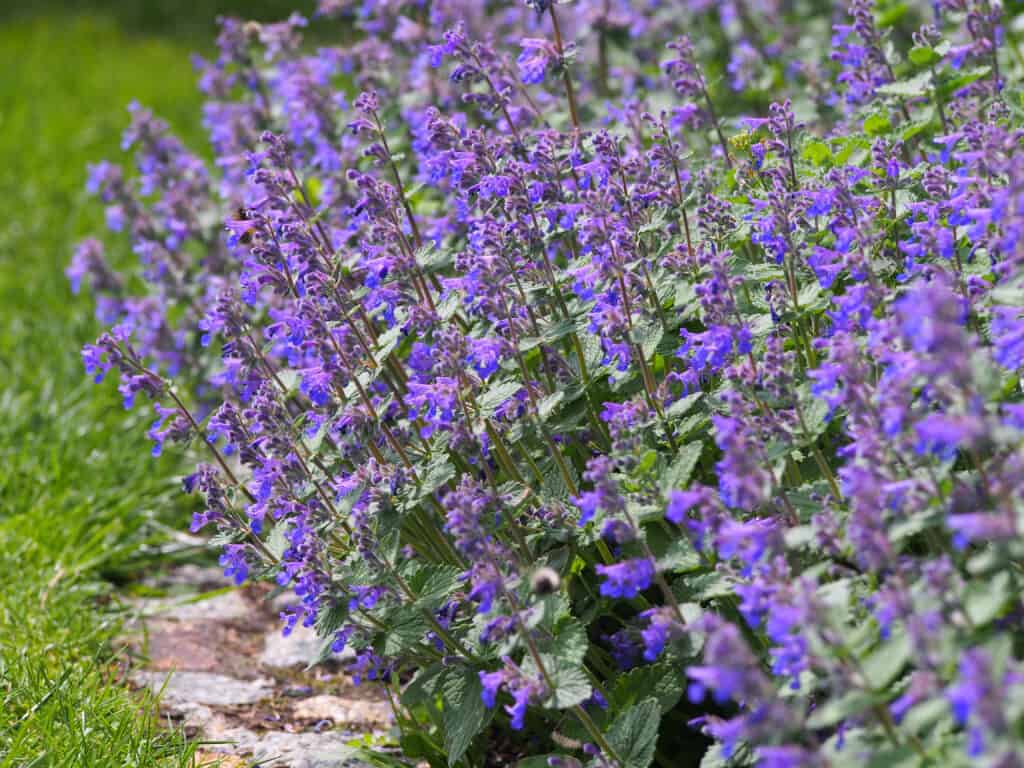
Catmint has a hallucinogenic effect on cats.
©Anna Gratys/Shutterstock.com
4. Creeping Thyme (Thymus serpyllum ‘Elfin’)
Elfin creeping thyme is a charming herb that, while not identical to traditional lavender, shares some of its visual characteristics and is an excellent ground cover option. Creeping thyme forms a low, dense mat of tiny, aromatic leaves that are reminiscent of lavender foliage. The leaves are small, oval-shaped, and typically have a gray-green coloration, providing a soft, silvery appearance.
Although creeping thyme is primarily cultivated for its foliage, it occasionally produces delicate, tubular flowers in shades of pink or lavender during the summer, further enhancing its charm. Elfin’s compact growth habit makes it an ideal choice for edging, rock gardens, or between stepping stones.
Plant creeping thyme in a location that receives full sun for most of the day. Well-draining soil is also crucial, but it is adaptable to various soil types. Once established, creeping thyme is drought-tolerant and prefers slightly drier conditions. Water sparingly, allowing the soil to dry out between waterings.
Trim back the plant after flowering to maintain its compact shape and encourage dense growth. Creeping thyme is generally resistant to pests and diseases, making it a low-maintenance ground cover option.
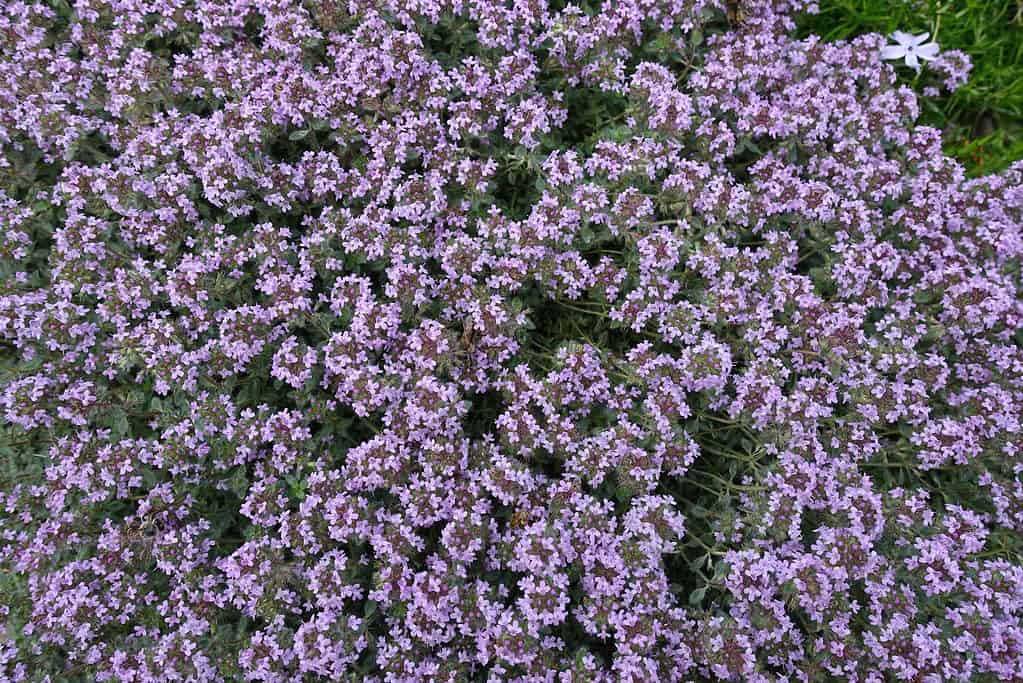
Honeybees are very attracted to creeping thyme, and the pollen flavors the resulting honey.
©iStock.com/apugach
5. French Tarragon (Artemisia dracunculus)
Another distinctive herb, French tarragon, exhibits captivating qualities that make it a unique addition to your garden. Its slender, lance-shaped leaves are a vibrant green and have a graceful, feathery appearance. While they may not resemble lavender’s broad, gray-green leaves as closely as some other specimens, French tarragon’s foliage exudes an elegance of its own.
What sets French tarragon apart is its delightful aroma—when you brush against its leaves, you are greeted with a sweet, anise-like fragrance. Specimens grow best in full sun, where they receive at least six hours of sunlight daily.
They also love well-draining soil and do not tolerate waterlogged roots. However, keep the soil consistently moist. French tarragon appreciates regular watering, especially during dry spells. Regularly trim back the plant to encourage bushier growth.
Add French tarragon’s aromatic leaves to culinary dishes and harvest leaves as needed. In colder climates, consider providing winter protection, such as mulch, to shield the plant from freezing temperatures.
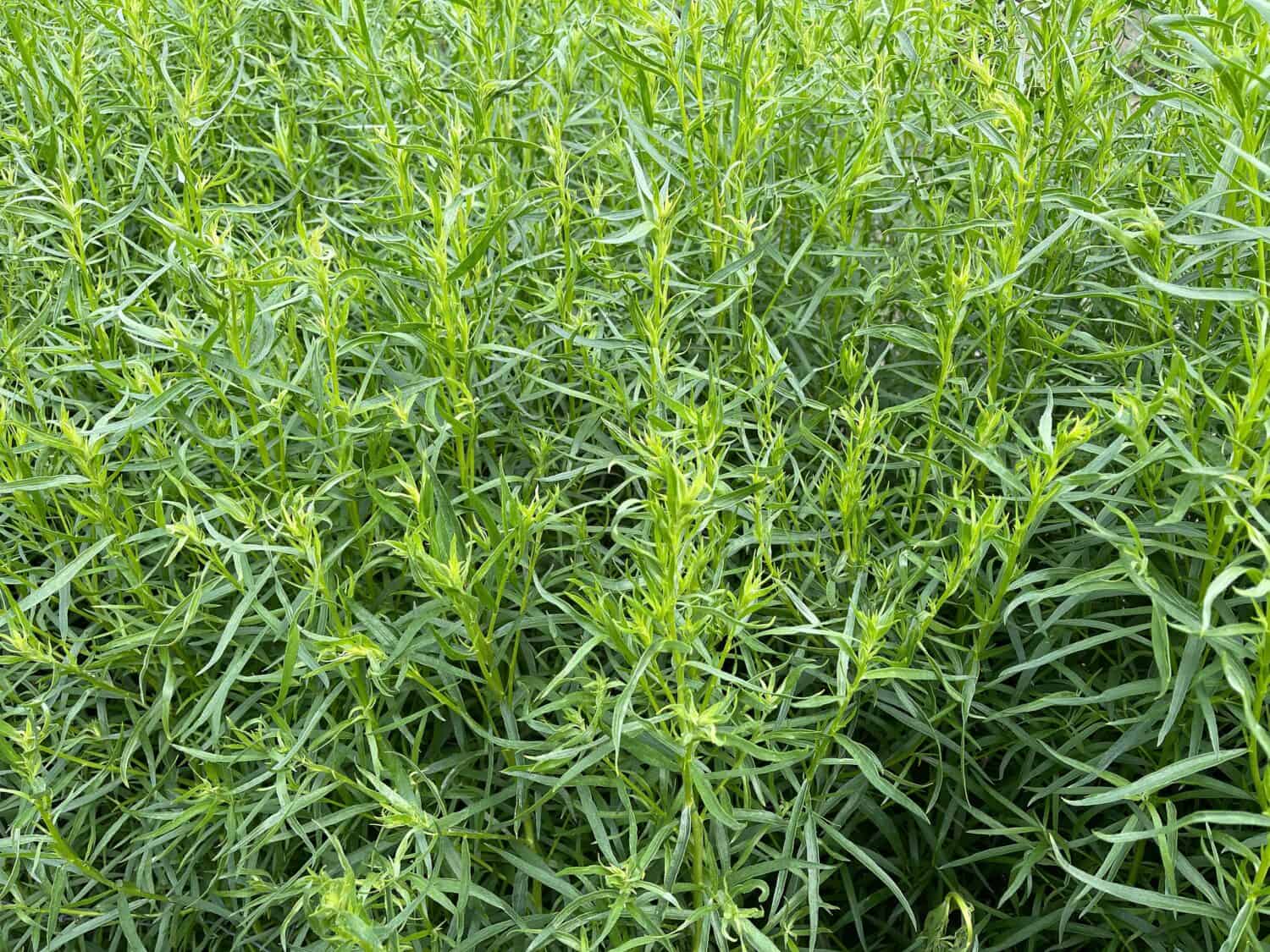
French tarragon tea treats insomnia by inducing sleep.
©Manfred Ruckszio/Shutterstock.com
6. Hebe (Hebe x franciscana ‘Silver Queen’)
Silver Queen hebe is an evergreen shrub known for its striking foliage that shares similarities with lavender in terms of color and texture. Its lance-shaped leaves are a cool grayish-blue hue, providing a visual contrast that echoes the soft, gray-green leaves of lavender.
This shrub forms a compact mound of foliage, making it an excellent choice for borders, hedges, or container planting. While hebe doesn’t produce traditional lavender-like blossoms, its foliage’s lavender-esque tones add a touch of elegance to your landscape.
Grow specimens in a location that receives full sun to partial shade, ensuring they get enough light for healthy growth. It also loves slightly acidic to neutral, well-draining soil. Additionally, keep the soil consistently moist, especially during dry spells. Regular watering supports its overall health.
Cut back hebe in the early spring to maintain its compact shape and remove any dead growth. Furthermore, apply a balanced, slow-release fertilizer in the spring to provide essential nutrients for optimal growth. In colder climates, consider protecting hebe from frost to ensure its survival.
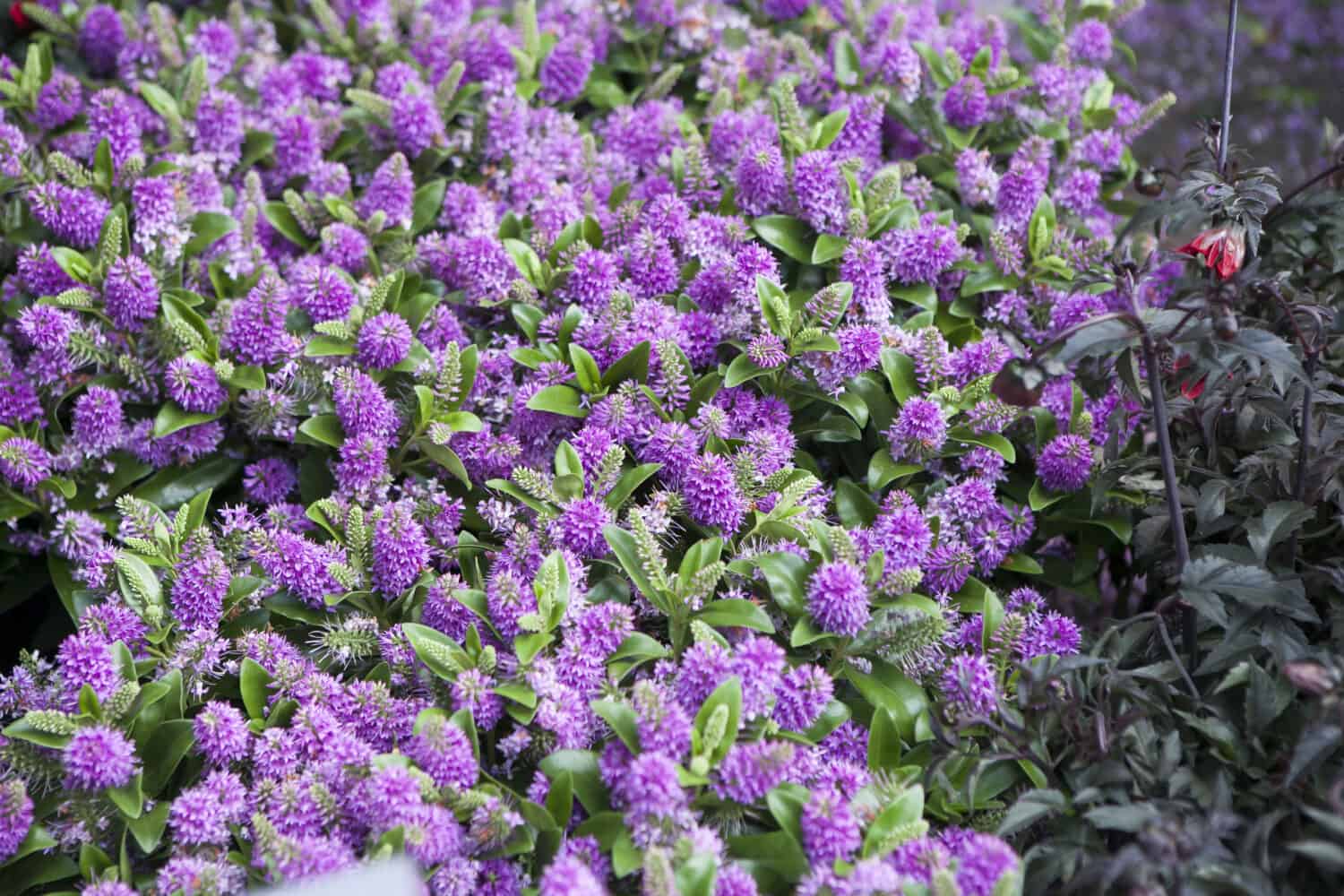
Hebe is the goddess of youth in Greek mythology.
©Elena Rostunova/Shutterstock.com
7. Heliotrope (Heliotropium arborescens)
Heliotrope is an enchanting plant that shares several visual similarities with lavender, making it a delightful alternative. Its oval-shaped, dark green leaves are rich and lush, providing a stunning contrast to its vibrant clusters of tiny, fragrant flowers. Heliotrope typically produces small, star-shaped blossoms in shades of lavender, purple, or blue, closely resembling the elegant inflorescences of lavender.
What truly sets heliotrope apart is its captivating fragrance — a sweet, vanilla-like scent, making it a favorite among garden enthusiasts seeking a lavender-inspired experience. Plant heliotrope in a location that receives full sun to partial shade, providing it with ample sunlight.
Ensure the soil is well-draining to prevent waterlogged roots but keep the soil consistently moist. Heliotrope also thrives in slightly acidic to neutral soil conditions. Regular watering is essential for maintaining its health and promoting flowering.
Prune the plant regularly to encourage bushier growth and remove spent flowers to prolong blooming. Additionally, apply a balanced, water-soluble fertilizer during the growing season to support healthy growth and flowering. In colder climates, consider overwintering heliotrope indoors or protecting it from frost to ensure its survival.
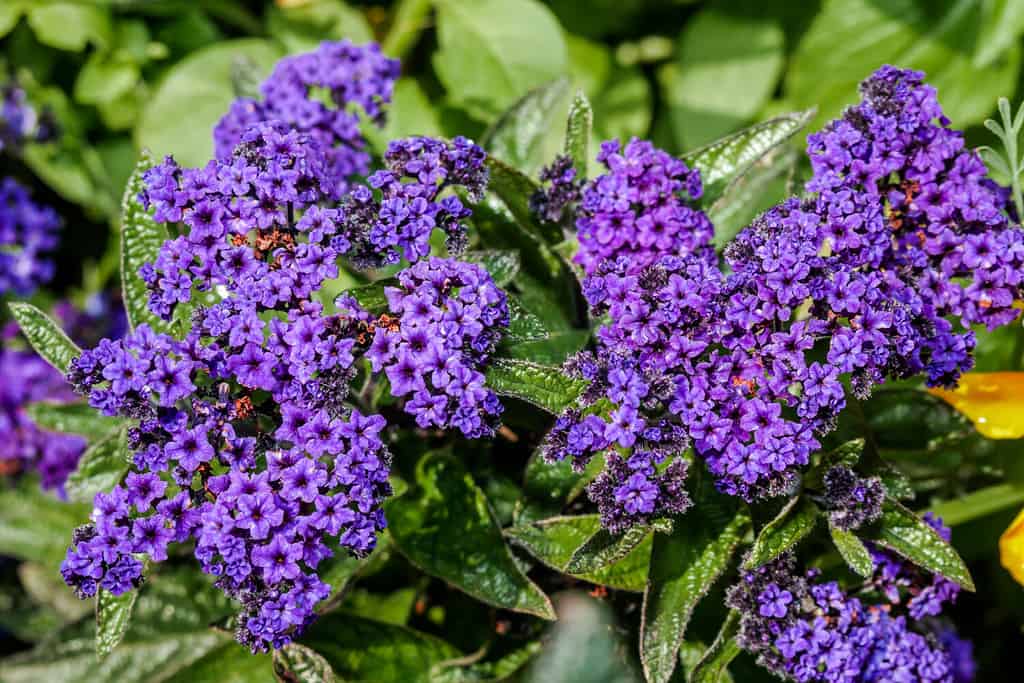
Heliotrope is native to Peru.
©Nick Pecker/Shutterstock.com
8. Lavender Cotton (Santolina chamaecyparissus)
Lavender cotton is a distinctive shrub that, while not a true lavender plant, offers an intriguing lavender-like appearance with its unique silver-gray foliage. Its dense, compact leaves are small, narrow, and highly aromatic, creating a silvery mound of foliage that closely resembles the overall aesthetic of lavender.
Unlike traditional lavender, lavender cotton is primarily grown for its captivating foliage rather than its flowers. It occasionally produces small, button-like yellow flowers, but its real charm lies in its foliage, which adds a touch of elegance and texture to your garden.
Lavender cotton thrives in full sun and well-draining, sandy soil. It is also tolerant of poor soil conditions and grows best in slightly alkaline to neutral soil. Once established, lavender cotton is drought-tolerant and prefers slightly dry conditions. Additionally, water sparingly to prevent waterlogged roots.
Like many specimens, prune lavender cotton regularly to maintain its compact shape and encourage new growth. You can also trim back its flower heads to promote bushier foliage. Lavender cotton is pest-resistant. Furthermore, you can propagate specimens through cuttings taken in spring or early summer.
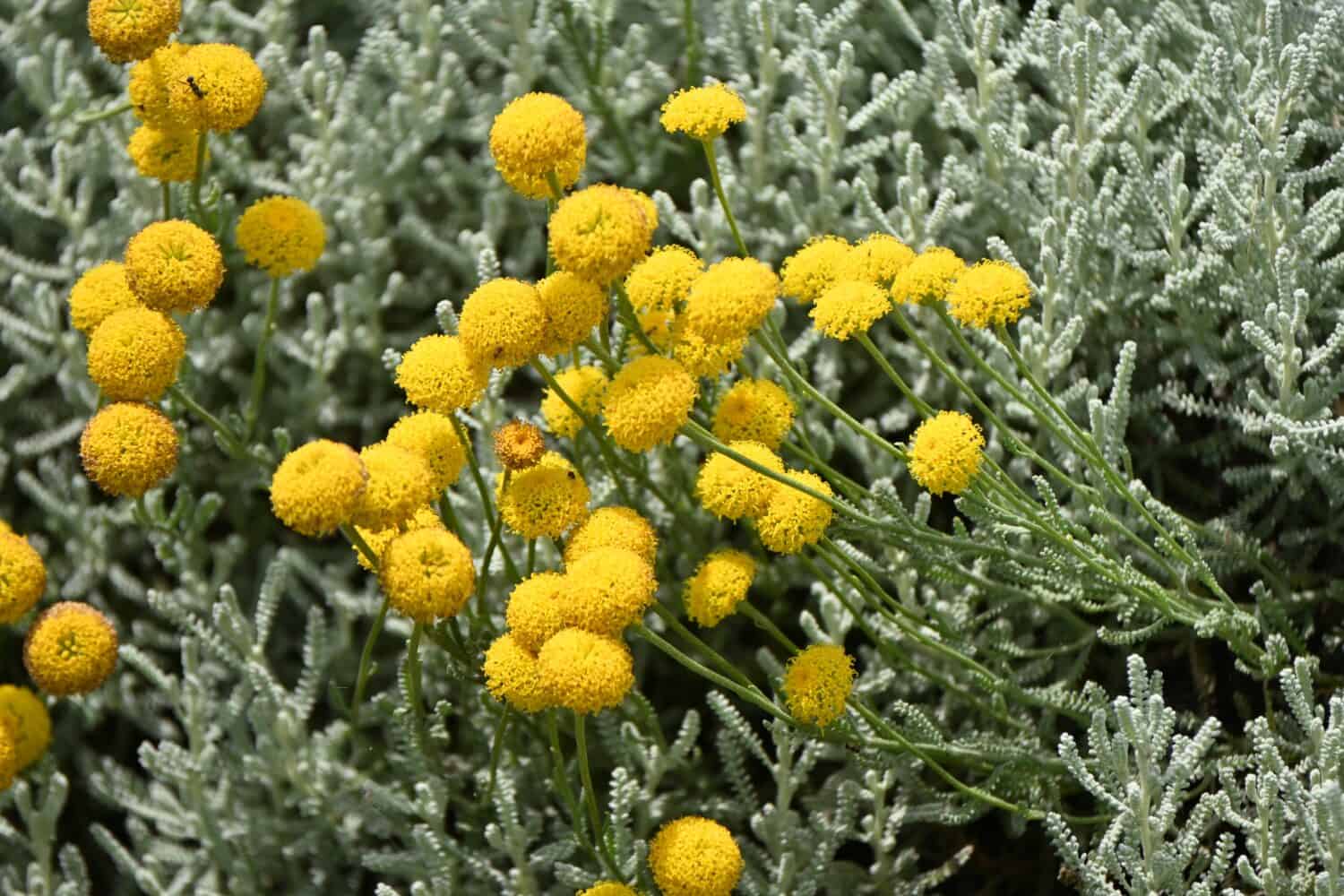
Lavender cotton has a variety of medicinal uses in the Mediterranean region.
©tamu1500/Shutterstock.com
9. Meadow Sage (Salvia pratensis)
This captivating wildflower exudes natural charm and shares visual similarities with lavender. Meadow sage produces lance-shaped leaves that are a rich green, and while they differ slightly from lavender’s foliage, they provide an appealing backdrop for its striking blooms.
Meadow sage also produces tall, slender spikes adorned with tubular flowers in shades of lavender, purple, or blue, closely resembling the elegant inflorescences of lavender. These blossoms not only evoke the charm of lavender but also attract a variety of pollinators, making specimens a delightful addition to wildflower meadows, cottage gardens, and naturalistic landscapes.
Meadow sage thrives in full sun to light shade but does its best flowering with ample light. Well-draining soil is also essential for this wildflower, though meadow sage can adapt to various soil types.
Keep the soil consistently moist, especially during dry spells. Adequate moisture supports healthy growth and blooming. Additionally, prune meadow sage after the first flush of blooms to encourage a second round of flowering and maintain a neat appearance.
Divide mature plants every few years to rejuvenate them and prevent overcrowding. Meadow sage is pest and disease-resistant, making it a low-maintenance wildflower for your garden.

Traditionally, meadow sage was used to flavor beer, wine, and vodka.
©olko1975/Shutterstock.com
10. Mexican Bush Sage (Salvia leucantha)
Mexican bush sage is a stunning plant that shares notable visual similarities with lavender while offering its distinct charm. This perennial sage features lance-shaped, gray-green leaves that closely resemble the foliage of lavender. However, what truly captures attention are its striking flower spikes.
Mexican bush sage produces tall, slender spikes adorned with velvety, tubular flowers in shades of lavender, purple, or white. These blooms bear a resemblance to the elegant inflorescences of lavender but come with their unique twist — soft, velvety bracts that give them a tactile allure. This combination of lavender-like leaves and velvety blossoms makes it a captivating choice for your garden.
Plant Mexican bush sage in a location that receives full sun to promote flowering. It also loves well-draining, slightly acidic soil. Keep the soil consistently moist during its growing season, but avoid overwatering to prevent root rot.
Prune specimens in the late winter or early spring to encourage new growth and remove any dead or leggy branches. In colder climates, provide winter protection by mulching around the base to shield it from frost.

Mexican bush sage is deer- and rabbit-resistant.
©Beach Creatives/Shutterstock.com
11. Rosemary (Rosmarinus officinalis)
This fragrant culinary herb shares some visual characteristics with lavender, particularly in terms of its foliage. Rosemary’s narrow, needle-like leaves are a deep green on top and silver-gray underneath, creating a distinctive and aromatic appearance that is reminiscent of lavender foliage.
While Rosemary is primarily grown for its culinary uses and aromatic qualities, its foliage’s color and texture closely resemble that of lavender leaves. Additionally, Rosemary occasionally produces small, tubular flowers in shades of lavender, blue, or white, adding a touch of color and charm to its overall aesthetic.
Rosemary needs at least six hours of direct sunlight daily. It also prefers well-draining, sandy soil. Allow the soil to dry out between waterings. Rosemary is drought-tolerant and is susceptible to root rot if overwatered.
Regularly trim and shape the plant to encourage bushier growth and prevent it from becoming leggy. Harvest rosemary leaves as needed for culinary purposes or to enjoy its aromatic qualities. Specimens are disease- and pest-resident. In colder climates, consider overwintering Rosemary indoors or providing protection from frost.

is derived from the Latin words that mean “dew of the sea.”
©Maren Winter/Shutterstock.com
12. Russian Sage (Perovskia atriplicifolia)
Gardeners love this perennial plant for its lavender-like appearance and distinctive qualities. Russian sage produces feathery, gray-green leaves that bear a striking resemblance to lavender foliage, with a silvery quality that adds an elegant touch to your garden.
Russian sage also produces tall, slender spikes of tiny, tubular flowers that appear in shades of lavender, blue, or purple. These blossoms form dense, aromatic clusters that closely mirror the structure of lavender blooms, making them an attractive alternative for those seeking a similar visual impact. Moreover, Russian sage’s fragrant leaves emit a pleasant aroma when brushed, enhancing its appeal.
Specimens thrive in bright, sunny conditions and well-draining soil. Once established, Russian sage is drought-tolerant and prefers slightly drier conditions. Water sparingly to prevent waterlogged roots.
Furthermore, prune Russian sage in the early spring to remove dead growth and encourage new shoots. You can also deadhead spent flowers to prolong blooming. Divide mature plants every few years to maintain their vigor and prevent overcrowding.
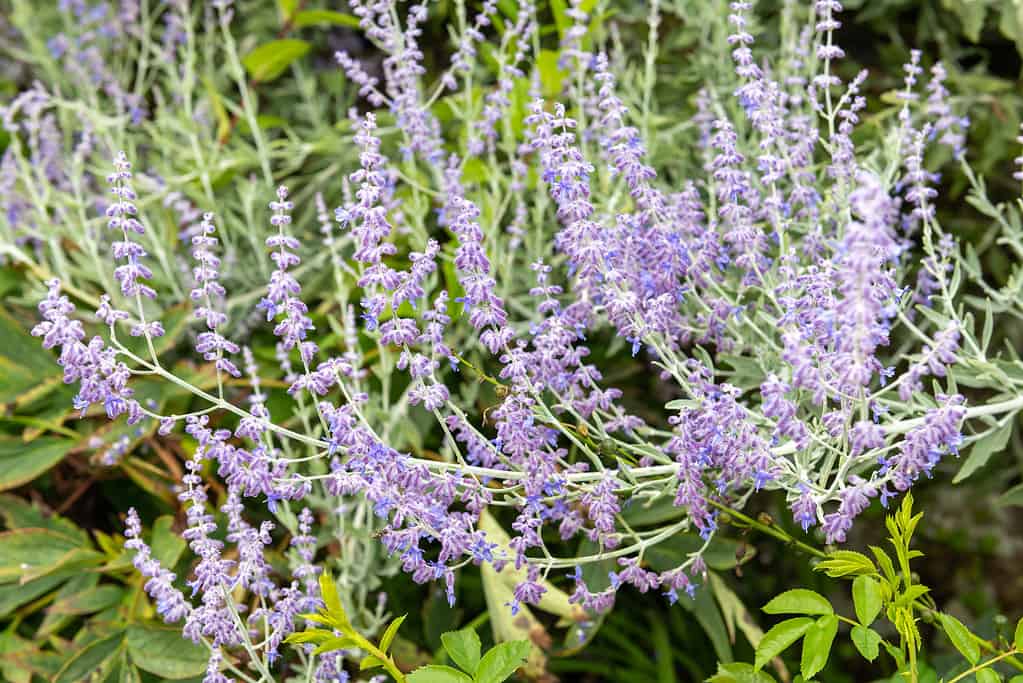
Russian sage blooms best in the late summer.
©Tom Meaker/ via Getty Images
13. Spiked Speedwell (Veronica spicata)
Spiked speedwell is a perennial plant admired for its lavender-like appearance and vertical elegance. Its lance-shaped leaves are deep green and arranged in a neat, upright fashion, resembling the foliage of lavender. This plant also produces impressive flower spikes.
Numerous tiny, tubular blossoms that form densely packed, vertical clusters adorn its tall, slender spikes. These blooms come in various shades, including lavender, violet, pink, and white, closely mirroring the inflorescences of lavender but in an elegant, towering display. Spiked speedwell’s vertical growth and lavender-like blooms make it a standout in gardens and borders.
Providing spiked speedwell with ample light promotes flowering, plant specimens in full sun to light shade. Additionally, they prefer well-draining soil. However, keep the soil consistently moist during the growing season to support its vertical growth and blooming.
Prune spiked speedwell after the first flush of blooms to encourage a second round of flowering and maintain a tidy appearance. Furthermore, divide mature plants every few years to rejuvenate them and prevent overcrowding.
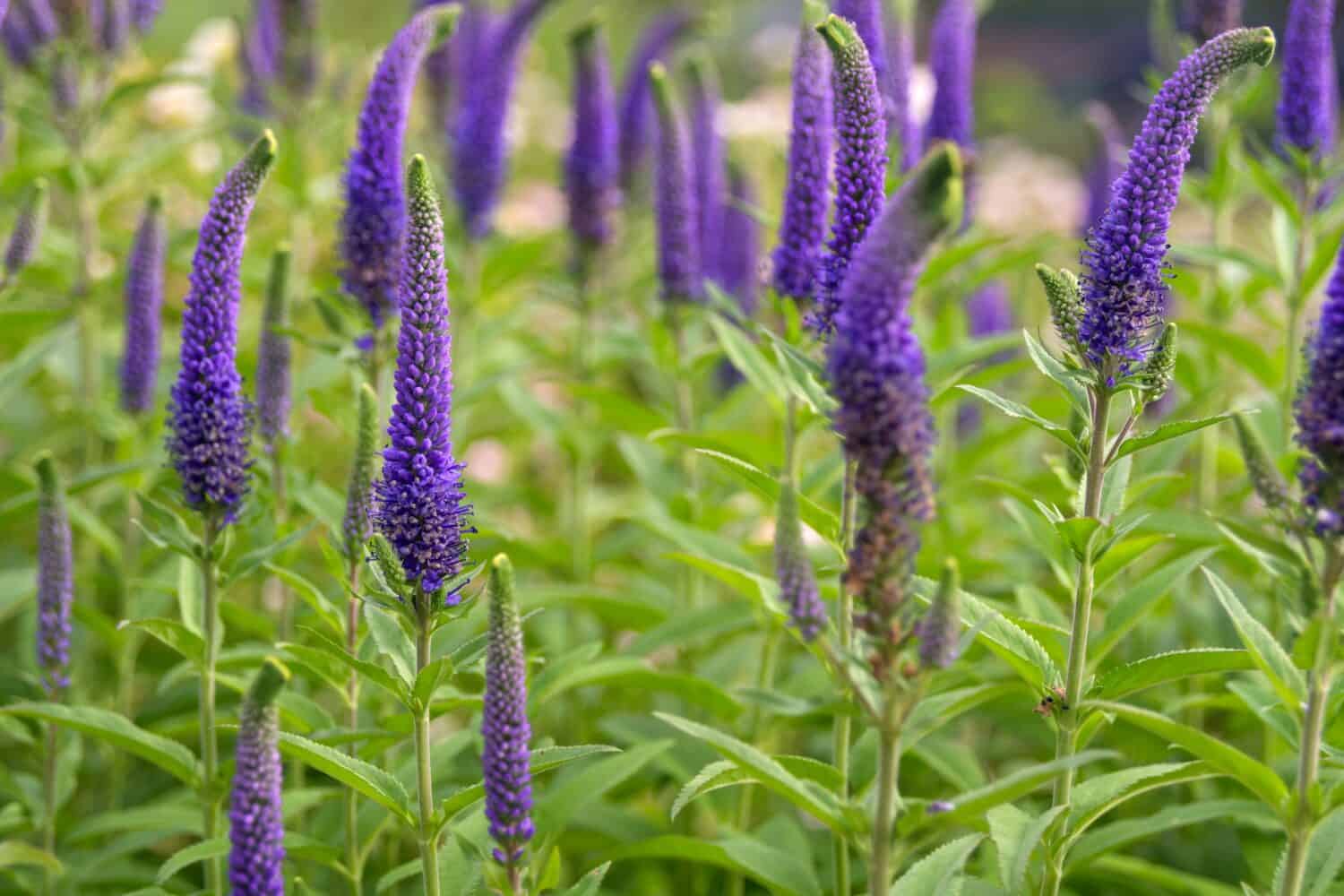
Spiked speedwell is a summer-blooming, low-maintenance perennial.
©l.lika/Shutterstock.com
14. White Sage (Artemisia ludoviciana)
White Sage, also known as white sagebrush or prairie sage, is an herbaceous perennial plant celebrated for its silver-gray foliage that shares visual similarities with lavender. Its leaves are slender, lance-shaped, and have a striking silvery-gray hue, creating a soft and elegant texture in your garden.
While it doesn’t produce lavender-like blossoms, white sage’s foliage exudes a charm of its own, reminiscent of lavender’s gray-green leaves. This plant’s unique color and texture make it a valuable addition to gardens seeking a lavender-inspired appearance.
White sage thrives in well-draining soil and full sun. It adapts to various soil types but prefers neutral conditions. Once established, white sage is drought-tolerant and disease- and pest-resistant. Prune specimens in the early spring to remove dead growth. Trimming can also help maintain its shape and prevent it from becoming leggy.
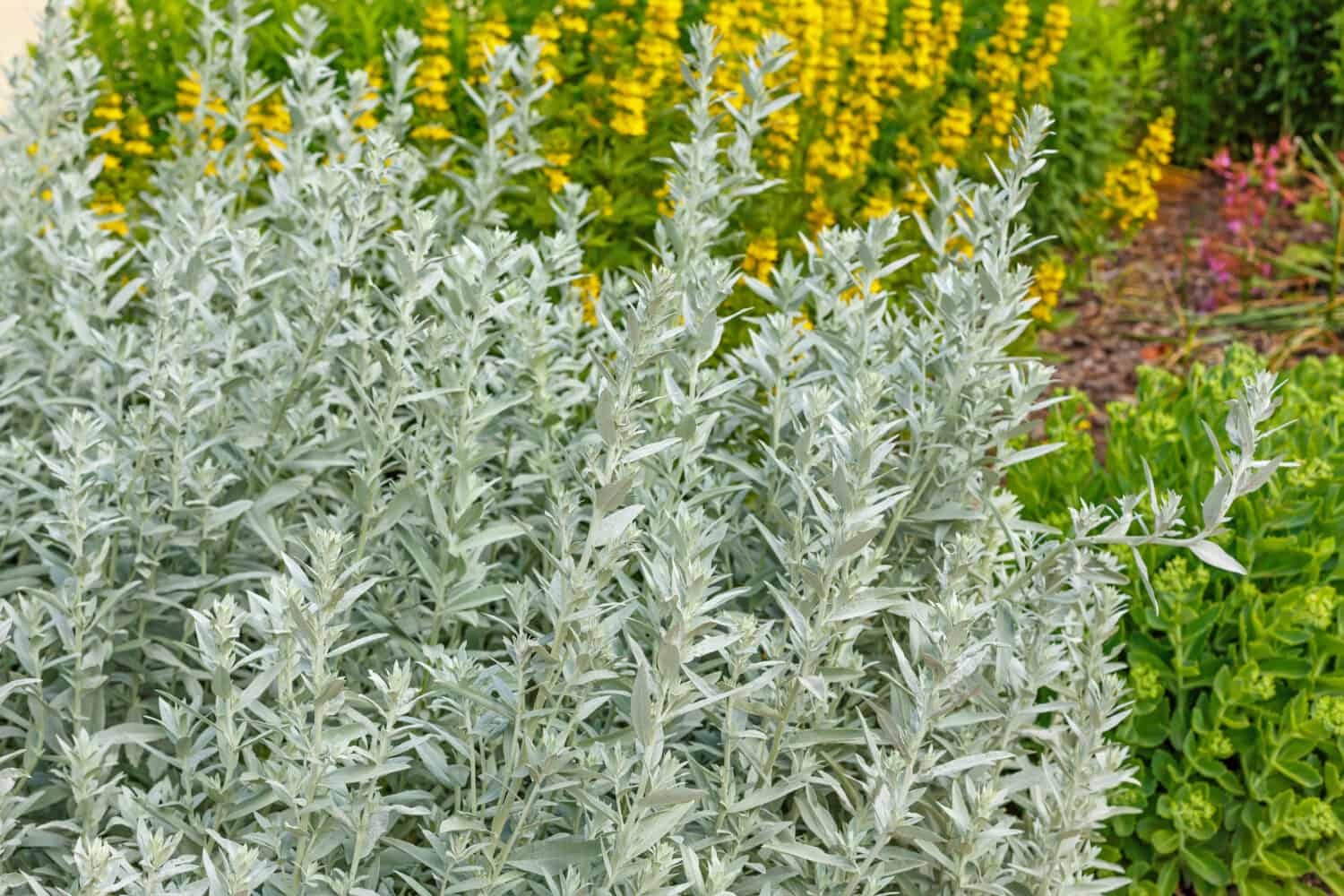
Indigenous peoples dried the leaves of white sage for tea.
©Flower_Garden/Shutterstock.com
15. Wild Bergamot (Monarda fistulosa)
Wild bergamot bee balm is another captivating herb that closely resembles lavender, both in its appearance and aromatic qualities. Its lance-shaped leaves are a vibrant green and occasionally feature subtle purplish hints, enhancing its visual appeal.
Furthermore, wild bergamot produces stunning blooms. This variety of bee balm blooms tall, slender spikes of tubular flowers in shades of lavender, pink, or purple. These blossoms closely mirror the charming appearance of traditional lavender flowers, adding a touch of elegance to your garden. Moreover, bee balm is a magnet for pollinators, making it an ecological asset to your outdoor space.
Plant wild bergamot in a location that receives full sun to partial shade, providing it with at least six hours of sunlight daily. Also, ensure the soil is well-draining soil to prevent waterlogged roots. However, maintain consistently moist soil. Adequate moisture helps prevent powdery mildew, a common issue with this plant.
Regularly deadhead spent flowers to encourage continuous blooming and divide mature plants every few years to rejuvenate them and prevent overcrowding. Keep an eye out for powdery mildew, a common issue with bee balm. Adequate air circulation and organic fungicides, if necessary, can help address this problem.
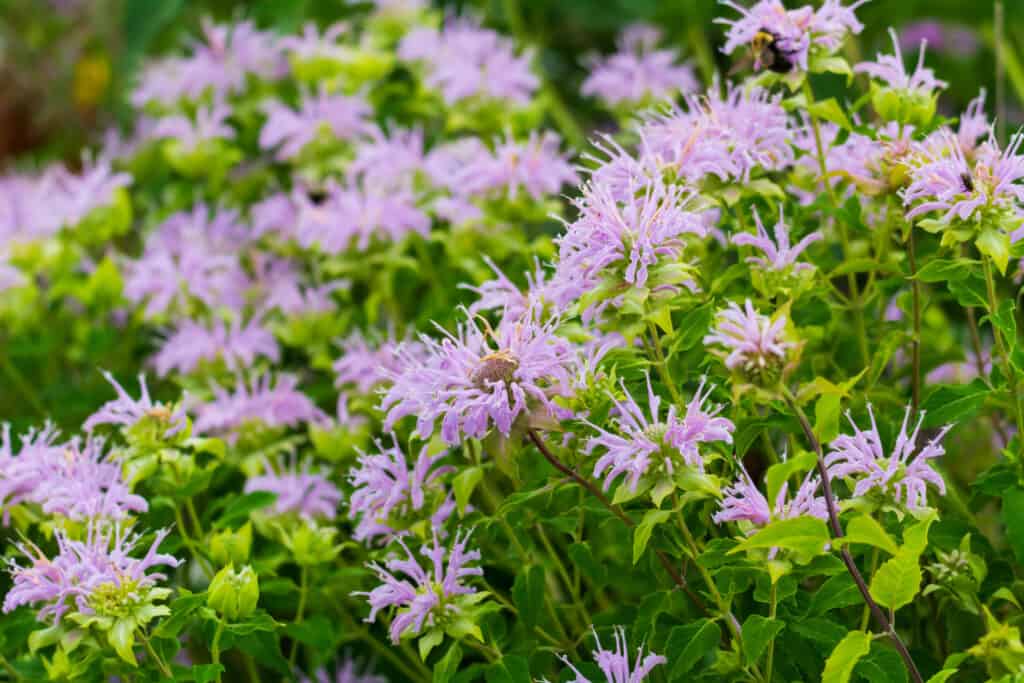
Dry wild bergamot leaves for mint tea.
©James W. Thompson/Shutterstock.com
16. Wisteria (Wisteria spp.)
Wisteria is a breathtaking and well-known climbing vine that exudes a sense of lavender-like elegance in its hanging blossoms. Its compound leaves are composed of small, oval leaflets, similar in shape to lavender leaves, though usually larger and greener in color.
Specimens also produce cascading clusters of pea-like flowers, which can drape gracefully from the vine in shades of lavender, purple, blue, or white. These pendulous blooms closely resemble the inflorescences of lavender but in a cascading, vine-like form. Wisteria’s floral display is not only visually stunning but also carries a lovely fragrance that fills the air, creating a sensory delight in gardens and arbors.
Plant wisteria in a location that receives full sun to promote prolific flowering. Well-draining soil is also crucial for this vine, and it prefers slightly acidic to neutral soil conditions.
Regular and careful pruning is essential to maintain the vine’s shape, promote flowering, and prevent overgrowth. Additionally, provide sturdy support for the vine, as it can become heavy as it matures. Trellises, arbors, or pergolas support wisteria’s climbing habit.
Keep the soil consistently moist during the growing season, especially for younger plants, to support their establishment. Furthermore, watch for pests and diseases, as wisteria is susceptible to issues like aphids and powdery mildew. Promptly address any problems that arise.

The world’s largest wisteria vine weighs over 250 tons.
©alexgo.photography/Shutterstock.com
Summary: 16 Plants That Look Like Lavender
| Number | Common Name | Season of Interest |
|---|---|---|
| 1 | African blue basil | Spring to fall |
| 2 | Anise hyssop | Late spring to early fall |
| 3 | Catmint | Late spring to early fall |
| 4 | Creeping thyme | Spring to summer |
| 5 | French tarragon | Late spring to early fall |
| 6 | Hebe | Year-round |
| 7 | Heliotrope | Summer to fall |
| 8 | Lavender cotton | Year-round |
| 9 | Meadow sage | Late spring to early summer |
| 10 | Mexican bush sage | Late summer to fall |
| 11 | Rosemary | Year-round |
| 12 | Russian sage | Late summer to fall |
| 13 | Spiked speedwell | Summer |
| 14 | White sage | Year-round |
| 15 | Wild bergamot | Summer to fall |
| 16 | Wisteria | Late spring to early summer |
Thank you for reading! Have some feedback for us? Contact the AZ Animals editorial team.

